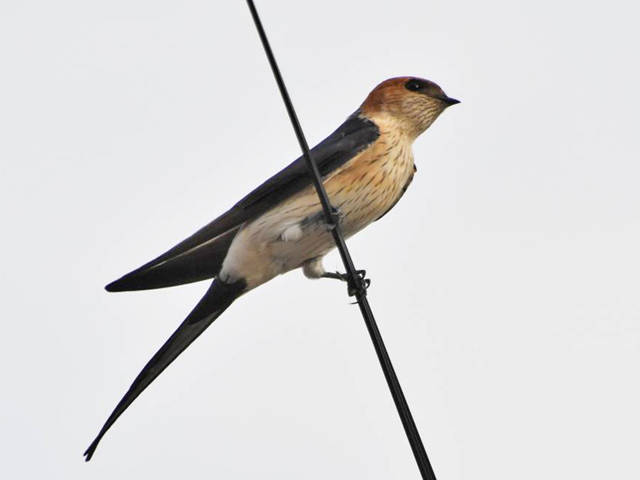
The Red-rumped Swallow is resemble the Barn Swallow by the proportion, size and long deep-cut tail. Adult male has the blackish-blue metallic glossed crown, mantle and scapulars. The neck and uppertail are rusty; the wings and tail are black-brown with slightly metallic gloss. In the middle parts of inner webs of the outer tail feathers there is a washed white spot. Undertail is black. Underparts are rufous-white with the longitudinal dark streaks on shafts of feathers. The rate of expression of these streaks varies on different subspecies. Underwings are buffy-whitish. Females are similar on males, but metallic gloss on plumage is slighter. Juveniles almost lack the metallic gloss (the head, mantle and scapulars are black-brown; the wings and tail are brownish). Besides juveniles have rusty-buff edges on the tips of wing coverts and especially on the secondaries. Underparts are buffier. The bill is black, legs are brown or blackish, eyes are black-brown. Weight 18-20 grams, male wing 115-119, female wing 112-116 mm.
The Red-rumped Swallow is common breeding migrant. It inhabits the cliff ledges, caves and cavities on mountains; lives also in villages, farms and towns; on plains, in foothills and in low mountains (Karatau, Chu-Iliyskiye Mts.), up to 2000 m. The Red-rumped Swallow is resemble the Barn Swallow by the behavior, habitude and constitution; but it more often breeds on the rock cavities than on villages and towns. It arrives in April singly, in pairs and small flocks. At Chokpak Pass last spring migrants recorded mid – late May. Pairs breed separately. The flask-shaped nest with the entrance tube is built on the rock ledge or on the constructions (especially on multistorey ones) and attached to the horizontal surface from below. Both partners build it for 5-15 days from the mud balls and line with thin grass and feathers. Old nests are repaired in case the entrance tube exists. Clutches of 2-6 (more often of 4-5) eggs found on end April – mid August. Both parents feed juveniles fledged on the three weeks old, from mid June to early October. Usually two broods are reared; repeat breeding after losing of the first nest is common. Autumn migration starts in mid August - September, majority of birds migrate mid September – early October. Last autumn migrants recorded in mid October. Often occurs in mixed flocks with Sand Martin, Barn Swallow and House Martin.
«Птицы Казахстана» под редакцией И.А.Долгушина, том 3, Алма-Ата, 1970.
Gavrilov E. I., Gavrilov A. E. "The Birds of Kazakhstan". Almaty, 2005.
В.К.Рябицев. "Птицы Урала, Приуралья и Западной Сибири". Екатеринбург, Изд-во Уральского университета, 2000.
Э.И.Гаврилов. "Фауна и распространение птиц Казахстана". Алматы, 1999.
А.Ф.Ковшарь "Певчие птицы". Алма-Ата, "Кайнар", 1983.